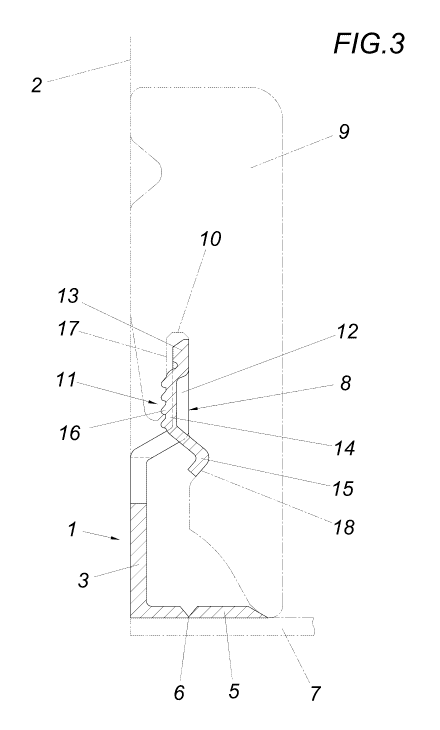Some of the information on this Web page has been provided by external sources. The Government of Canada is not responsible for the accuracy, reliability or currency of the information supplied by external sources. Users wishing to rely upon this information should consult directly with the source of the information. Content provided by external sources is not subject to official languages, privacy and accessibility requirements.
Any discrepancies in the text and image of the Claims and Abstract are due to differing posting times. Text of the Claims and Abstract are posted:
| (12) Patent Application: | (11) CA 3197711 |
|---|---|
| (54) English Title: | DEVICE FOR FASTENING A FINISHING STRIP |
| (54) French Title: | DISPOSITIF POUR FIXER UNE BAGUETTE DE FINITION |
| Status: | Compliant |
| (51) International Patent Classification (IPC): |
|
|---|---|
| (72) Inventors : |
|
| (73) Owners : |
|
| (71) Applicants : |
|
| (74) Agent: | SMART & BIGGAR LP |
| (74) Associate agent: | |
| (45) Issued: | |
| (86) PCT Filing Date: | 2021-06-28 |
| (87) Open to Public Inspection: | 2022-04-14 |
| Availability of licence: | N/A |
| (25) Language of filing: | English |
| Patent Cooperation Treaty (PCT): | Yes |
|---|---|
| (86) PCT Filing Number: | PCT/AT2021/060226 |
| (87) International Publication Number: | WO2022/073045 |
| (85) National Entry: | 2023-04-03 |
| (30) Application Priority Data: | ||||||
|---|---|---|---|---|---|---|
|
The invention relates to a device for fastening a finishing strip (9) with a holder (1) forming a wall leg (3), said holder comprising a receiving web (8) which protrudes upwardly and is arranged offset transversely to the wall leg (3) as well as engages into a downwardly open receiving groove (10) of the finishing strip (9) for the clamping accommodation of the finishing strip (9), and further comprising a resilient locking tongue (11) which is bent out of the receiving web (8) and latches into a latching recess (18) of the finishing strip (9). In order to provide advantageous fastening conditions, it is proposed that the locking tongue (11) forms a clamping web (14), which originates from the free longitudinal edge (13) of the receiving web (8) and is bent out towards the wall leg (3), and an adjoining latching web (15) which is bent back against the receiving web (8) and which latches into the latching recess (18) of the finishing strip (9).
L'invention concerne un dispositif pour la fixation d'une baguette de finition (9) avec un support (1) formant un pied de paroi (3), ledit support comprenant une bande de réception (8) qui fait saillie vers le haut et est disposée de manière décalée transversalement par rapport au pied de paroi (3) et qui s'engage dans une rainure de réception (10) s'ouvrant vers le bas de la baguette de finition (9) pour la réception avec serrage de la baguette de finition (9), et comprenant en outre une languette de verrouillage élastique (11) qui est pliée vers l'extérieur de la bande de réception (8) et se verrouille dans un évidement de verrouillage (18) de la baguette de finition (9). Afin d'offrir des conditions de fixation avantageuses, il est proposé que la languette de verrouillage (11) forme une bande de serrage (14), qui part du bord longitudinal libre (13) de la bande de réception (8) et est pliée vers l'extérieur en direction du pied de paroi (3), ainsi qu'une bande de verrouillage (15) adjacente qui est repliée contre la bande de réception (8) et qui se verrouille dans l'évidement de verrouillage (18) de la baguette de finition (9).
Note: Claims are shown in the official language in which they were submitted.
Note: Descriptions are shown in the official language in which they were submitted.

For a clearer understanding of the status of the application/patent presented on this page, the site Disclaimer , as well as the definitions for Patent , Administrative Status , Maintenance Fee and Payment History should be consulted.
| Title | Date |
|---|---|
| Forecasted Issue Date | Unavailable |
| (86) PCT Filing Date | 2021-06-28 |
| (87) PCT Publication Date | 2022-04-14 |
| (85) National Entry | 2023-04-03 |
There is no abandonment history.
Last Payment of $125.00 was received on 2024-06-04
Upcoming maintenance fee amounts
| Description | Date | Amount |
|---|---|---|
| Next Payment if standard fee | 2025-06-30 | $125.00 |
| Next Payment if small entity fee | 2025-06-30 | $50.00 if received in 2024 $58.68 if received in 2025 |
Note : If the full payment has not been received on or before the date indicated, a further fee may be required which may be one of the following
Patent fees are adjusted on the 1st of January every year. The amounts above are the current amounts if received by December 31 of the current year.
Please refer to the CIPO
Patent Fees
web page to see all current fee amounts.
| Fee Type | Anniversary Year | Due Date | Amount Paid | Paid Date |
|---|---|---|---|---|
| Application Fee | 2023-04-03 | $421.02 | 2023-04-03 | |
| Maintenance Fee - Application - New Act | 2 | 2023-06-28 | $100.00 | 2023-04-04 |
| Maintenance Fee - Application - New Act | 3 | 2024-06-28 | $125.00 | 2024-06-04 |
Note: Records showing the ownership history in alphabetical order.
| Current Owners on Record |
|---|
| NEUHOFER, FRANZ |
| Past Owners on Record |
|---|
| None |